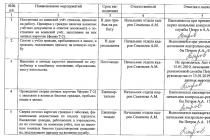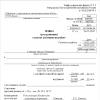The most important subject market economy are organizations engaged in the production of goods and services and (or) their sale. In this regard, the organization is the general name of any economic production unit: firms, enterprises. And since, in its structure, a firm can consist of both one enterprise and include a number of enterprises, it will be incorrect in all cases to use the concepts of “firm” and “enterprise” as synonyms. This is justified only in the case when a firm is understood as an independent production unit consisting of one enterprise. But only. When a firm is understood as a large corporation, which is a complex of a number of enterprises, the independence of which, although limited, is preserved, then the identification of the concepts of "firm" and "enterprise" is unacceptable.
The production of goods and services for which there is demand is carried out by a variety of enterprises (firms).
An enterprise (firm) is an economic unit that owns or has economic possession and operational management of separate property and has rights that allow it to perform specific functions for the production and (or) sale of goods and services under its property responsibility for the purpose of making a profit or providing social significant services. Depending on the purpose of functioning, enterprises (firms) are divided into commercial, striving to maximize profits, and non-commercial, functioning to provide various kinds of socially significant services available to the general population, regardless of their income (education, healthcare, culture, urban passenger transport, etc.). etc.).
An enterprise (firm) as a form of organization of production economic activity is the main production and economic link of the economy, since it is it that is engaged in the creation of economic benefits and (or) their implementation. As a production and economic link, an enterprise (firm) is characterized by technical, industrial and organizational unity. On the one hand, an enterprise (firm) is a complex of means of production with technological unity, adapted to create certain economic benefits. On the other hand, an enterprise (firm) is a team of workers connected with each other in the production process by labor cooperation and common economic interests. Within the framework of this technical, production and organizational unity, an enterprise (firm) acts as an economically separate business entity.
Economic isolation is the most important feature of the enterprise. It is due to the essential nature of the enterprise as a commodity producer, carrying out its individual reproduction. The economic isolation of the enterprise is manifested in the isolation of the resources of the enterprise and their independent movement in the process of reproduction; in the implementation of this reproduction due to the results of management on the principles of self-sufficiency; in the presence of their specific interests and their purpose of management. The economic isolation of an enterprise implies economic independence, the degree of which to a certain extent depends on the place of the enterprise in the system of property relations, on what appropriation functions (possession, disposal and use) are implemented by the entities engaged in economic activities at the enterprise. Along with the form of ownership within which the enterprise operates, the degree of its economic independence is determined by the normative acts of the relevant superstructural institutions that regulate the activities of the enterprise. The target orientation of such acts, for example, in relation to large and small, public and private enterprises can be very different. And therefore, the degree of their economic independence will also be different.
In a market economy, there are many different enterprises (firms), which requires their classification depending on certain criteria. These may be the type of activity, industry, or products; organizational and legal form; dimensions; form of ownership, etc.
Organizational and legal forms of enterprises. Any enterprise, in order to be able to engage in entrepreneurial activities, must be registered with the relevant legal form. Depending on the legal form, sole proprietorship is distinguished ( individual entrepreneurship) and association of entrepreneurs.
Sole proprietorship is literally the independent conduct of business in one's own interests. Owner has material resources and capital equipment necessary for business activities, and personally supervises these activities, while bearing unlimited liability for its obligations.
Association of entrepreneurs is carried out in the form of partnerships (partnerships) and companies. A partnership (partnership) is a form of business organization in which two or more individuals agree on the ownership and management of the enterprise. They usually combine their financial resources and business skills. In a similar way, they share risks, as well as profits or losses that may fall to their share, while bearing unlimited property liability for the obligations of the firm. A limited liability company is such a legal form of association of capital investors, in which the participants are liable for the obligations of the company only with their contribution. The contribution made gives the right to receive part of the profit in the form of dividends and the right to vote. The leading form of limited liability companies is a joint-stock company - a corporation. A corporation is an association of capital investors - shareholders, but such an association in which the property of the corporation is completely separated from the property of shareholders. In the event of a company's insolvency, shareholders are not liable for its obligations to creditors, but only risk a possible depreciation of shares.
The firm as a form of organization entrepreneurial activity
4.1.1. A distinction must be made between an enterprise and a firm.
4.1.2. The firm as an economic entity.
4.1.3. The firm as an economic organization.
The institutional nature of the firm consists in the pooling of economic resources under the authority of the entrepreneur, who organizes their use in the interests of the production of goods and services.
It is necessary to distinguish between the enterprise and the firm
This division in economic theory is done in order to separate the production-technical and technical-economic problems of production, which are the subject of specific economic disciplines, from the problems of making economic decisions related to production, and the principles of the relationship of the subjects that accept them.
Enterprises
- these are special production units, which are characterized by: the performance of one or more functions for the production and distribution of goods and services; concentration of specialized means of production and work force In one place; specialized organization methods production process. IT - factories, plants, mines, farms, shops, etc. They represent technological links production system of society.
From the point of view of the relations that develop between the owners of the factors involved in the production of enterprises, they can take different forms. For example, in the Soviet economy, the pooling of resources for production was a function of the state. The form of the enterprise was a "socialist enterprise", subordinate to the center, which makes decisions about the volume of production and the range of output. In a market economy, the decision to combine resources for production, on the volume of output, is made by the entrepreneur, who acts independently and bears economic responsibility for his decisions. The company operates like a firm.
Firm
is an organization formed and managed for the purpose of making a profit by its owners through the production of one or more goods for sale on the market.
A firm may consist of one or several enterprises.
Firm - This name under which the entrepreneur conducts his business.
Firm - this is an organization registered in the appropriate legal form.
The firm as an economic entity
The firm as a business entity, has a special purpose of activity and its own economic interest, organizes production at enterprises at your own expense, on your risk and bears property responsibility based on performance results. Signs of the company as an economic unit, leading commercial activity, are:
1. Availability responsible owner who conducts business at this enterprise, which determines the purpose of its activities, directions of development and is responsible for the results of decisions made. In the Russian Federation, the problem of the emergence of a responsible owner in the 1990s was solved in the course of corporatization, privatization, and the establishment of a system government controlled property, formation of a system of responsibility of the owner for the results of activities. To date, this task has not been finally resolved, the institution of ownership is blurred, the rights of the owner are poorly protected both by law and informal norms.
2. The firm is economically independent It makes independent decisions about what, how and for whom to produce. Russian enterprises have never before dealt with the actual "brand problems" associated with the economic choice of areas of activity: the search for a market niche, the choice of a range of production, independent search partner, marketing problems, etc. Currently, the development of market principles of independent and independent management is underway.
3. The company operates under the conditions "hard budget" constraints. Independent management assumes that the company measures its planned costs and sources of income. stands out four rules budget constraints: the buyer fulfills the agreements concluded and pays for the goods received; the borrower does not violate the provisions of loan agreements and pays his debts; taxpayer pay taxes; companies cover their expenses from their income. In the Russian Federation, there is still a problem of non-separation of enterprise finances from state finances: direct state financing; breach of credit agreements; non-payments to the state; non-payments of enterprises production chain.
transformation Russian enterprise to the firm is thus not completed. There are a sufficient number of loopholes through which it can shift its costs to counterparties. This reduces her interest in rational use resources and leads to a decrease in the efficiency of the distribution of resources in society.
There is a wide variety of organizations. They differ from each other in a number of ways. The Civil Code of the Russian Federation distinguishes primarily commercial and non-profit organizations. commercial organization pursues the extraction of profit as the main goal of its activities. Not commercial organization does not pursue this goal, and if it makes a profit, then the latter is not distributed among its participants. Thus, business entities (enterprises) include commercial organizations that are created in the form of:
- ? business partnerships;
- ? business companies;
- ? production cooperatives;
- ? state and municipal unitary enterprises.
Organizational and legal forms suggest that enterprises differ both in terms of ownership and other elements:
- ? the status of the owner of the applied capital;
- ? method of distribution of profits and losses;
- ? the number of participants in this business entity;
- ? limits of property liability;
- ? sources of property;
- ? forms of management.
The owner of an enterprise may be the state or a private person (persons). If in authorized capital of a business entity is a share of state and private property, then such an enterprise has a mixed form of ownership. The municipal form is a kind of state form of ownership. Public and religious organizations can also be the owner of an economic entity. For enterprises with such forms of ownership, the main goal is not to make a profit and increase capital, but to perform the statutory functions of creative unions, confessions and other similar structures.
Enterprises are created as a joint-stock company (open and closed), a limited liability company, an additional liability company, a unitary enterprise, a leased enterprise, a cooperative, a general and limited partnership, etc.
The most common forms of management are a joint-stock company (JSC) and a limited liability company (or partnership) (LLC or LLP). The procedure for the formation of property, distribution of profits and liability between the participants of the company is determined by the charter. Compensation for damages to third parties in case of bankruptcy is carried out within the limits equity. The sequence of satisfaction of creditors' claims is regulated by law. The main difference between a joint-stock company and a limited liability company is that a JSC issues shares in the amount of authorized capital, issues them to their owners, maintains a register of shareholders, and in an LLC, the share contribution of the owners is established as a percentage.
Enterprises are divided into large, medium and small according to their size. The enterprise belongs to one of the subgroups according to the characteristics specified in legislative or by-laws. Small enterprises with a small number of employees, profits or sales have additional incentives compared to large ones in the form of tax incentives or other motivational mechanisms that contribute to the development and strengthening of small businesses.
Thus, regardless of the form of ownership main task organization as an economic entity (enterprise) is an activity that does not contradict the law and is aimed at making a profit. Economic activity can be production, trade, transport, insurance, engineering, etc.
Industrial firms include firms with more than 50% of their turnover accounted for by the production of industrial products. For large industrial companies characterized by the transformation into complex diversified complexes, uniting a large number of industrial enterprises various industries and various production profiles.
Trading companies are mainly engaged in the implementation of operations for buying and selling goods. They can either be part of the distribution system of large industrial companies, or they can exist legally and in economic relations independently from other firms and carry out trade and intermediary operations. Trading firms are either highly specialized or trading in a wide range of products. Among trading firms, large monopolistic associations stand out, occupying a dominant position in the world market for individual goods or in the foreign trade turnover of individual countries. So, the vast majority international trade sugar, non-ferrous metals, grain, rubber, cotton, furs, timber, hides is concentrated in the hands of not a large number large specialized trading companies. Many large trading companies carry out production activities associated not only with the processing of raw materials that they trade, but also with the products of other industries, both in their own country and abroad.
Transport companies transport goods and passengers. Usually transport companies specialize in certain types of transportation, in connection with which among them are shipping, road, air, rail.
The vast majority of insurance operations are concentrated in the hands of giant insurance companies, dominated by US companies. The latter account for over 60% of the volume of insurance operations performed on the world market.
Freight forwarding firms specialize in carrying out operations for the delivery of goods to the buyer, carrying out orders from industrial, commercial and other firms. The functions of transport-forwarding companies are very diverse. This includes checking the condition of containers and packaging, labeling, execution of shipping documents, payment of the cost of transportation on behalf of the cargo owner, loading and unloading operations, storage, insurance, selection and assembly of small shipments, informing the consignee about the arrival of the cargo, obtaining a commercial act (if the cargo was damage), the implementation of customs formalities, the organization of container transportation, the provision of freight shipments with quarantine, sanitary and veterinary supervision documents, etc.
Any newly created business entity begins its activities with the choice of a mission and the development of a strategy.
Enterprises and organizations are the object of microeconomic statistics. Both of these concepts are interrelated and do not contradict each other. Let us consider how the concept of "enterprise" was formed in statistics.
In statistics, great importance is attached to the description of the observed object, process, phenomenon. In this regard, there is the concept of a unit of observation. The unit of observation is the primary object, the features of which are subject to description in the process statistical observation. The choice of the unit of observation depends on the purpose of the study. For example, the unit of observation may be an employee of an enterprise as a carrier of certain characteristics (specialties, education, etc.) Employees may have different specialties, levels of education, wage. However, the reporting unit will be the enterprise. Often, an enterprise is both a unit of observation and a reporting unit (when studying investment activity).
In the process of formation and development of domestic statistics, the concept of an enterprise was refined to collect and process statistical data on various sectors of the economy. In pre-revolutionary Russia, an independent enterprise was considered such a production unit that belonged to one owner (legal entity), all parts of which were located on one land plot and were served by a single source of energy, which was taken into account in the censuses. For example, the industrial census of 1900 covered enterprises subordinate to the factory inspection. The census program highlighted the following items: the amount of production, the main products, the cost of domestic and imported equipment, workforce by sex and age, the number of working hours and engine power. Since the late 1920s, when defining the concept of an enterprise, the signs of “administrative and economic isolation due to the production unity of all components” were taken into account. This approach combines the production-technical and organizational-economic aspects of the enterprise.
In connection with the reform of the Russian economy, the enterprise began to be regarded as a subject of law, as an economic category.
An enterprise as an economic category is understood as economic agents or persons operating in a market economy, engaged in the production and (or) sale of goods and market services for the purpose of making a profit. In this interpretation, we meet the concept of "goal", which brings us closer to understanding the enterprise as an organization. The hallmarks of an organization are:
The presence of at least two people who consider themselves part of this group;
The presence of a common goal for all members of this group;
Achieving a common goal based on the division of labor.
Thus, an organization is a group of people whose activities are coordinated to achieve a common goal. Enterprise as an organization - a set individuals united to realize the mission of the organization based on the division of labor. The organization has at least one common goal recognized by all members of the organization. However, organizations rarely have only one purpose. This is typical for simple organizations. Complex organizations may have a set of interrelated Goals and consist of many independent enterprises.
An example of such organizations are corporations and other subjects of a market economy. Complex organizations are not only groups that are purposeful in their activities, but also have General characteristics. To be successful, an organization must be managed.
Any organization must have the resources to deliver results. This - human resources, capital, materials, technologies and information.
Enterprises (organizations) are completely dependent on external environment(in relation to resources, consumers, economic conditions, legislation, etc.). Environmental factors affect the processes associated with the forms of division of labor:
Horizontal separation when constituent parts general activities are divided into components;
A vertical division of labor that separates the work of coordinating actions from the actions themselves.
Significantly important activity for any organization is management. Management work should be separated from non-managerial work. Organizations appoint managers and define their duties and responsibilities.
The company produces goods, provides services to meet public needs. The enterprise has administrative and economic independence, i.е. the rights of a legal entity, organizational and technical unity, common goals of activity.
In a market economy, production is any type of activity that generates income.
As a legal entity, an enterprise owns, manages or manages separate property and is liable for its obligations with this property. An enterprise may, on its own behalf, acquire or exercise property and personal non-property rights, be liable, act as a plaintiff and defendant in court.
The company may have representative offices and branches. Both the representative office and the branch are separate subdivisions of the enterprise as a legal entity. They are located outside the location of the enterprise, are not independent legal entities (they cannot be a party to the contract, acquire and exercise property and personal non-property rights on their own behalf, incur obligations, be a plaintiff and defendant in court, do not have the right to conclude an agreement with the person who created them organization). Representative offices and branches are endowed with property by the legal entity that created them. The head of a branch (representative office) acts on the basis of a power of attorney.
The functions of representative offices and branches, as well as the powers of the head of the branch (representative office) related to their performance, are determined by the relevant regulation. The regulation reflects the features of their accounting and reporting.
The representative office represents the interests of the enterprise as a legal entity and protects them; promotes the organization of exhibitions, the conclusion of contracts, performs other functions related to the promotion of the company's products to the market.
A branch can perform the functions of an enterprise as an economic entity, but it can also perform representative functions. A branch performs broader functions than a representative office, it can have its own revenue, costs and financial results.
Representation is a costly unit.
Branches and representative offices can be allocated to a separate balance sheet, which is used in management purposes and for the preparation of consolidated financial statements.
An enterprise that has a permanent place of residence in a given country is a resident. Russian organization(resident) are any organization registered and operating in Russia, including those owned by a foreign owner, and joint venture. A non-resident organization is an organization (including branches and subsidiaries of Russian legal entities) registered and operating abroad. As a rule, non-residents are organizations that pay taxes on activities in favor of a foreign state.
The enterprise carries out:
Current activities (manufacturing of products, provision of services, leasing of property, etc.), the main purpose of which is to make a profit;
investment activity ( capital investments in the acquisition of land plots, buildings and other real estate, equipment, intangible assets and other non-current assets, as well as their sale; making long-term financial investments in other organizations, issuing bonds and other valuable papers long term);
Financial activities (short-term financial investments, issuance of bonds and other short-term securities, etc.).
Enterprises operate in various sectors of the economy.
Depending on the average headcount employees of the enterprise can be: small, medium, large, super-large.
In accordance with federal law"ABOUT state support small business in Russian Federation» dated May 12, 1995, No. 88-FZ, small businesses include commercial organizations (legal entities) in which the number of personnel for the reporting year (period - for newly created ones), including those working under civil law contracts and part-time jobs, does not exceeds: in industry, construction and transport - 100 people; V agriculture and scientific and technical sphere - 60 people; V retail, non-production types of consumer services for the population - 30 people; V wholesale trade, in other industries and in the implementation of other activities - 50 people.
At the beginning of 2002, there were 843 thousand small enterprises in Russia, of which 14.8% were in industry, 14.5% in construction, 46% in trade and catering.
In national and international statistical practice, medium-sized enterprises include enterprises with an average payroll employed, not exceeding 5000 people.
To large enterprises in accordance with national qualification statistics and foreign - with an average payroll of up to 10,000 people.
Super-large (giants) include enterprises with an average headcount of more than 10,000 people.
Statistical observations are based on the application of the qualification approach.
Large and medium-sized enterprises are covered by complete reporting; small enterprises are subject to selective observation with subsequent dissemination of the results to the entire set of small enterprises. This approach imposes certain requirements on the formation of the observed population, i.e., the determination of the number of small enterprises and the subsequent selection of objects included in the sample survey.
When analyzing the number of small enterprises, two figures characterizing different values should be distinguished: the number of registered and the number of operating enterprises. The number of operating small enterprises serves as the basis for creating a general population of objects of statistical observation and the subsequent selection of enterprises included in the sample survey. The number of registered determines the number to which the results of sample observations apply.
The success of an enterprise is largely determined by the validity organizational structure and schemes of management, management system and marketing. Of particular importance in a market economy is the quality management system, which is based on a process approach to enterprise management and ensures the supply of products to the consumer, taking into account his requirements.
Large economic objects co complex structure may consist of a large number of frequently changing legal entities engaged in heterogeneous activities, structurally located in different geographical areas. Increasingly strong positions in the economy are being won by corporate associations, in which diversification processes are intensively developing.
Currently, there are several types of statistical units. The most important among them are:
Company;
Unit of activity;
Local unit (territorially separate subdivisions);
Local unit of activity.
The basis for organizing and conducting state statistical observations is the Unified State Register of Enterprises and Organizations (USRE).
Unified state register of enterprises and organizations - state Information system, consisting of an organizationally ordered set of documents and information technologies, providing accounting and identification of economic entities passing state registration on the territory of the Russian Federation.
The Unified State Register of Enterprises and Organizations represents the general set of objects of statistical observation (operating legal entities, their representative offices and branches), contains information about the main type of activity and general economic indicators.
The purpose of creating the USREO is to accumulate and use in the public interest accounting and statistical data reflecting the creation and development throughout life cycle enterprises and organizations that are characterized by a standard set of details.
The Unified State Register of Enterprises and Organizations makes it possible to uniquely identify business entities and their main characteristics; to form a general population (GS) of objects of statistical observation for the organization of statistical observations.
When forming the general population of objects of statistical observation, first of all, attention is paid to the fact that the enterprises included in it are active. In the event of liquidation of accounting entities, their exclusion from the registers is envisaged. However, a certain number of enterprises are liquidated without deregistration in the statistical authorities.
The distribution of enterprises and organizations registered in the USREO by sectors of the economy is carried out according to the type of activity declared first in the constituent documents of enterprises and organizations.
At the beginning of 2003, there were 3845.3 thousand enterprises and organizations in Russia, of which 421.1 thousand were in industry, 1389.2 thousand were in trade and public catering, and 78.7 thousand were in management.
An important feature of modern entrepreneurship is the instability of the life cycle, i.e., an extremely strong susceptibility to the processes of emergence and liquidation of enterprises.
To study these processes, attempts are being made to use the methods, concepts and indicators used in demography, in particular the survival and mortality rates. The essence of the demographic approach is that the set is divided into a number of subsets based on the corresponding characteristics of the subjects. In demographics, there are such characteristics as gender, nationality, Family status, place of residence, etc. In our case, the relevant features are the main economic activity, the size of the enterprise, the legal status, and the nationality of the owners.
To organize the monitoring of changes in the statistical population of enterprises, it is necessary to clarify what should be considered the birth and death of an enterprise.
For example, entry into the aggregate may be due to the emergence of new, separation, separation, transformation of existing enterprises, and exit from the aggregate may be associated with liquidation, merger, accession, change in the main economic activity, size, moving to another region.
The solution to the above problems is ambiguous and will always be conditional. For their practical solution, statistical authorities need to develop special instruction despite the fact that Article 57 of the Civil Code of the Russian Federation defines the reorganization of a legal entity.
First of all, it is essential to substantiate important characteristics firms that can be used to judge its changes (for example, to talk about the emergence of a new unit, which was preceded by the liquidation of an existing one or about the continuation of the activities of an existing unit), as well as in each specific case, differently evaluate the weight of each characteristic. The amount of weight depends on the size of the enterprise. Thus, a change of ownership for a small business will result in the loss of the identity of the business, while for large enterprises this factor is usually not significant.
Of great practical interest is the determination of such indicators as average duration the life of an enterprise, the average number of changes by enterprises of their main economic activity during their existence, etc.
Longitudinal analysis, or the cohort method, can be used to study these processes. Events that occur with enterprises are described and analyzed in cohorts, i.e., aggregates that simultaneously entered into any state (for example, entities that began their activities in the same year). Each year, a cohort record can be kept of how many active businesses remain.
Information resources of the Goskomstat of Russia are formed on the basis of more than 200 forms of federal statistical observation with different frequency (annual, quarterly, monthly). Once every few years, one-time surveys are carried out. The total amount of input information is about 186 thousand indicators.
Let us consider the main forms of organization of statistical observation in microeconomic statistics.
Accounting is required to keep all legal entities located in the country. In accordance with the Civil Code, a legal entity is an organization that has separate property in ownership, economic management or operational management and is liable for its obligations with this property, can acquire and exercise property and personal non-property rights on its own behalf, bear obligations, be a plaintiff and a defendant in a court.
Organizations can be commercial (Fig. 1) and non-commercial (Fig. 2). Commercial organizations have the main goal of their activities to make a profit, while non-profit organizations do not have such a goal and do not distribute the profits among the participants.
Business partnerships and companies are commercial organizations with authorized (share) capital divided into shares (contributions) of founders (participants). All property economic partnership(society) belongs to him by right of ownership.
Business partnerships can be created in the form of a general partnership and a limited partnership (limited partnership). A partnership is recognized as full, the participants of which, in accordance with the agreement concluded between them, are engaged in entrepreneurial activities on behalf of the partnership and are liable for its obligations with their property. Members of a general partnership can be individual entrepreneurs as well as commercial organizations.
A limited partnership (limited partnership) is a partnership in which, along with the participants who carry out entrepreneurial activities on behalf of the partnership and are liable for the obligations of the partnership with their property, there are one or more participants-contributors (limited partners) who bear the risk of losses associated with the activities of the partnership , within the limits of the amounts of contributions made by them and do not take part in the implementation of entrepreneurial activities by the partnership. Members of a limited partnership may be individual entrepreneurs, commercial and non-commercial organizations, citizens.
Business partnerships may be formed in the form joint-stock company, limited liability companies or with additional liability.
A joint stock company is a company whose authorized capital is divided into a certain number of shares. Shareholders are not liable for the obligations of the company and bear the risk of losses associated with the activities of the company, within the value of their shares. Shareholders who have not fully paid their shares shall be jointly and severally liable for the obligations of the company to the extent of the unpaid portion of the value of their shares.
Joint-stock companies can be open and closed. Participants in an open joint stock company may alienate their shares without the consent of other shareholders. Such a company, in accordance with the law, has the right to conduct an open subscription for shares issued by it and their sale. In a closed joint-stock company, shares are distributed only among its founders or other predetermined circle of persons. The shareholders of such a company have preemptive right acquisition of shares sold by other shareholders of this company. The number of shareholders of a closed company must not exceed fifty.
A limited or additional liability company is a company founded by one or more persons, the authorized capital of which is divided into shares of the sizes determined by the constituent documents.
Members of a limited liability company are not liable for its obligations and bear the risk of losses associated with the activities of the company, to the extent of the value of their contributions. Members of the company who have made contributions not in full shall be jointly and severally liable for its obligations within the value of the unpaid part of the contributions of each of the participants. A limited liability company cannot have as its sole participant another economic company consisting of one person.
Participants in a company with additional liability jointly and severally bear subsidiary liability for the obligations of the company with their property in the same multiple for all of the value of their contributions, determined by the constituent documents of the company. In the event of bankruptcy of one of the participants in such a company, liability for the obligations of the company is distributed among the remaining participants in proportion to their contributions, unless otherwise provided by the constituent documents of the company.
Business partnerships and companies may have subsidiaries, and business companies- dependent companies. A business company is recognized as a subsidiary if another (main) business company or partnership, by virtue of its predominant participation in its authorized capital, or in accordance with an agreement concluded between them, or otherwise, has the ability to determine decisions made by such a company. A business company is recognized as dependent if another (predominant, participating) company has more than twenty percent of the voting shares of a joint-stock company or twenty percent of the charter capital of a limited liability company.
In the form of production cooperatives (artels), voluntary associations of citizens are created on the basis of membership for joint production or other economic activities (production, processing, marketing of industrial, agricultural and other products, performance of work, trade, consumer services, provision of other services), based on their personal labor and other participation and association of property share contributions by its members (participants). The number of members of the cooperative must not be less than five. The law and constituent documents of a production cooperative may provide for the participation of legal entities in its activities. Production cooperative is a commercial organization.
Only state and municipal enterprises can be created in the form of unitary enterprises. A unitary enterprise is a commercial organization that is not endowed with the right of ownership of the property assigned to it by the owner. Property unitary enterprise is indivisible and cannot be distributed among contributions (shares, shares), including between its employees; is respectively in state or municipal ownership and belongs to such an enterprise on the right of economic management or operational management.
Non-profit organizations can carry out entrepreneurial activities only insofar as it serves the achievement of the goals for which they were created, and corresponding to these goals.
A consumer cooperative is a voluntary association of citizens and legal entities on the basis of membership in order to meet the material and other needs of the participants, carried out by combining property shares by its members.
Public and religious organizations (associations) are recognized as voluntary associations of citizens who, in accordance with the procedure established by law, have united on the basis of their common interests to satisfy spiritual or other non-material needs. Participants (members) of public and religious organizations do not retain the rights to property transferred by them to these organizations in ownership, including membership fee. They are not liable for the obligations of these organizations in which they participate as their members, and these organizations are not liable for the obligations of their members.
Foundation - non-membership non-profit organization, established by citizens and (or) legal entities on the basis of voluntary property contributions, pursuing social, charitable, cultural, educational or other socially useful goals. The property transferred to the foundation by its founders (founder) is the property of the foundation. The founders are not liable for the obligations of the fund they have created, and the fund is not liable for the obligations of its founders. The procedure for managing the fund and the procedure for forming its bodies are determined by its charter approved by the founders. In order to carry out entrepreneurial activities, foundations have the right to create business companies or participate in them.
An institution is an organization created by the owner to perform managerial, socio-cultural or other functions of a non-commercial nature and financed by him in whole or in part. A state-owned enterprise, as well as an institution in relation to the property assigned to them, exercise the rights of possession, use and disposal of it within the limits, statutory, in accordance with the objectives of its activities, the tasks of the owner and the purpose of the property. The institution is liable for its obligations with the resources at its disposal. in cash. In case of their insufficiency, the owner of the relevant property bears subsidiary liability for its obligations.
Legal entities may have representative offices and branches. The representative office is separate subdivision legal entity located outside its location, which represents the interests of the legal entity and protects them. A branch is a separate subdivision of a legal entity located outside its location and performing all or part of its functions, including the functions of a representative office. Representative offices and branches are not legal entities. They are endowed with property by the legal entity that created them and act on the basis of the provisions approved by it. Heads of representative offices and branches are appointed by a legal entity and act on the basis of its power of attorney. Representative offices and branches must be indicated in the constituent documents of the legal entity that created it. Entity is considered created from the moment of its state registration.














